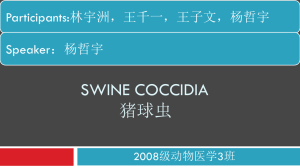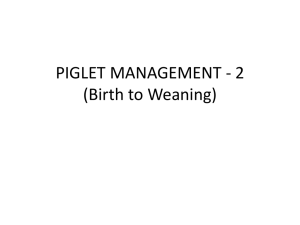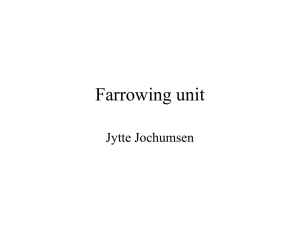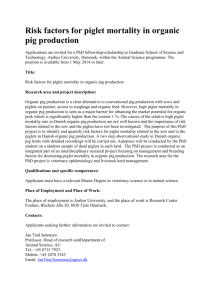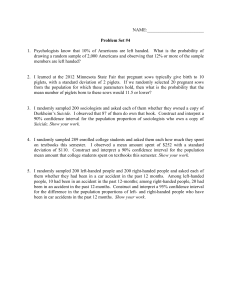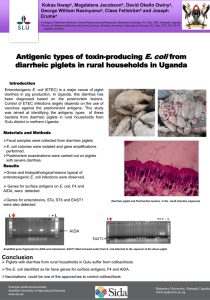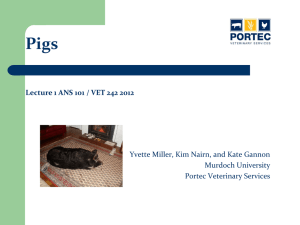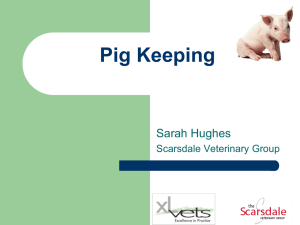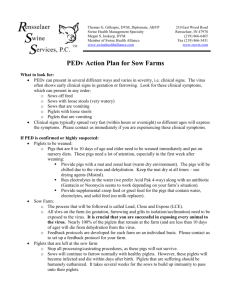Effect of additional heating, floor length, straw quantity and piglet
advertisement
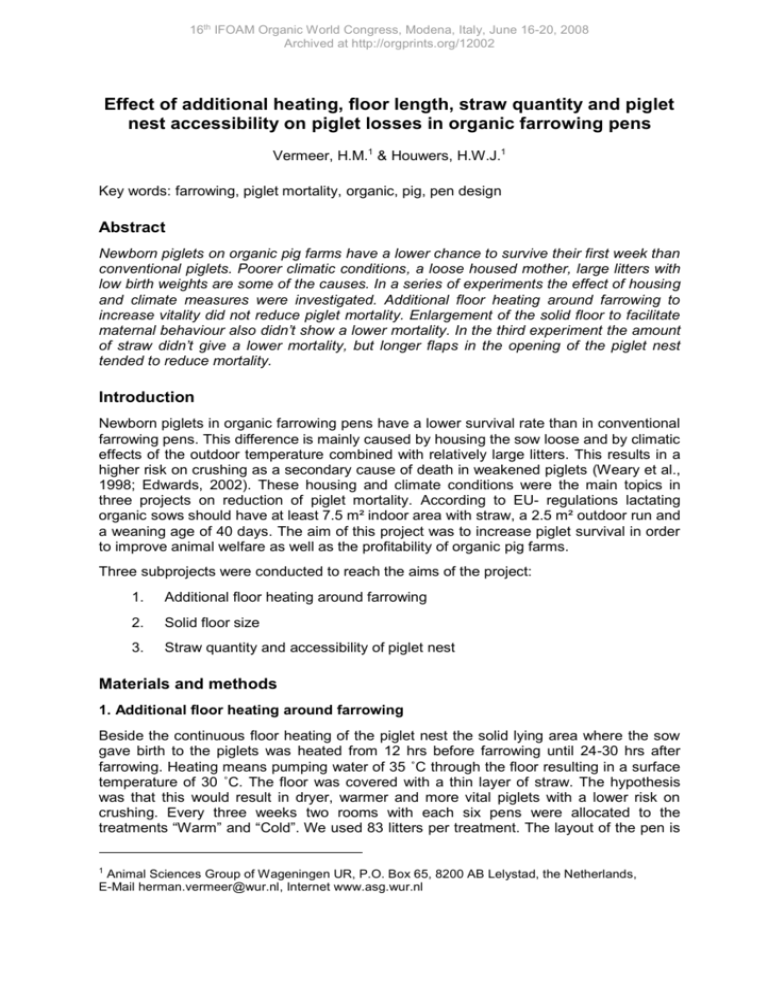
16th IFOAM Organic World Congress, Modena, Italy, June 16-20, 2008 Archived at http://orgprints.org/12002 Effect of additional heating, floor length, straw quantity and piglet nest accessibility on piglet losses in organic farrowing pens Vermeer, H.M.1 & Houwers, H.W.J.1 Key words: farrowing, piglet mortality, organic, pig, pen design Abstract Newborn piglets on organic pig farms have a lower chance to survive their first week than conventional piglets. Poorer climatic conditions, a loose housed mother, large litters with low birth weights are some of the causes. In a series of experiments the effect of housing and climate measures were investigated. Additional floor heating around farrowing to increase vitality did not reduce piglet mortality. Enlargement of the solid floor to facilitate maternal behaviour also didn’t show a lower mortality. In the third experiment the amount of straw didn’t give a lower mortality, but longer flaps in the opening of the piglet nest tended to reduce mortality. Introduction Newborn piglets in organic farrowing pens have a lower survival rate than in conventional farrowing pens. This difference is mainly caused by housing the sow loose and by climatic effects of the outdoor temperature combined with relatively large litters. This results in a higher risk on crushing as a secondary cause of death in weakened piglets (Weary et al., 1998; Edwards, 2002). These housing and climate conditions were the main topics in three projects on reduction of piglet mortality. According to EU- regulations lactating organic sows should have at least 7.5 m² indoor area with straw, a 2.5 m² outdoor run and a weaning age of 40 days. The aim of this project was to increase piglet survival in order to improve animal welfare as well as the profitability of organic pig farms. Three subprojects were conducted to reach the aims of the project: 1. Additional floor heating around farrowing 2. Solid floor size 3. Straw quantity and accessibility of piglet nest Materials and methods 1. Additional floor heating around farrowing Beside the continuous floor heating of the piglet nest the solid lying area where the sow gave birth to the piglets was heated from 12 hrs before farrowing until 24-30 hrs after farrowing. Heating means pumping water of 35 ˚C through the floor resulting in a surface temperature of 30 ˚C. The floor was covered with a thin layer of straw. The hypothesis was that this would result in dryer, warmer and more vital piglets with a lower risk on crushing. Every three weeks two rooms with each six pens were allocated to the treatments “Warm” and “Cold”. We used 83 litters per treatment. The layout of the pen is 1 Animal Sciences Group of Wageningen UR, P.O. Box 65, 8200 AB Lelystad, the Netherlands, E-Mail herman.vermeer@wur.nl, Internet www.asg.wur.nl 16th IFOAM Organic World Congress, Modena, Italy, June 16-20, 2008 Archived at http://orgprints.org/12002 drawn in figure 1. Lying behaviour of sow and piglets was observed during the first five days post partum and post mortem section of the piglets was carried out to check the stomach content and the status of the lungs (live or dead born). Performance data and fraction dead piglets were analysed using GLM (Genstat) with litter size and birthweight as covariables in the model beside the main effects. 2. Solid floor size To give sows the opportunity to perform a higher quality of maternal behaviour the surface of the 2.0 m wide solid floor was elongated from 2.25 m (Small) to 3.00 m (Large). This resulted in “Large” in a decreased slatted floor size from 1.50 m to 0.75 m deep (see fig.1). In both treatments 42 litters were born. Lying position of sows and piglets, dunging pattern and performance were recorded. 3. Straw quantity and accessibility of piglet nest In this 2x2 factorial design we used 112 litters. Half of the pens was strawed with a thin layer and half with a thick layer of straw just before birth. The second factor was the accessibility of the piglet nest (grey area in fig. 1): long transparent flaps (ending 8 cm above the floor) and short flaps (ending 30 cm above the floor). Lying position of sows and piglets, sow posture changes and performance were recorded. anti crushing bar outdoor run trough solid floor with straw tribar slatted floor tribar slatted floor opening + flaps 200 cm inspection alley drinker piglet feeder 200 manure piglet nest 225 (300) 150 (75) 87.5 87.5 cm Figure 1: Layout of two farrowing pens with different solid floor sizes in the indoor area; the outdoor area is on the right in the drawing. Results 1. Additional floor heating around farrowing The extra heat during farrowing did not result in a lower piglet mortality. The performance of the sows in the two treatments was not statistically different. Table 1 shows the results. On average 12.63 liveborn piglets in “Cold” resulted in 10.12 weaned piglets and for “Warm” 12.36 liveborn piglets resulting in 9.94 weaned piglets. This leads to a mortality of respectively 20.0 and 19.4% (NS). 16th IFOAM Organic World Congress, Modena, Italy, June 16-20, 2008 Archived at http://orgprints.org/12002 Tab. 1: Performance of sows farrowing on a heated and non-heated floor. Cold Liveborn (number) 12.63 Stillborn (number) 1.19 Birthweight (kg) 1.51 Weaned (number) 10.12 Mortality (% of liveborn) 20.0 Weight loss sow (kg) 32 * significant for P<0.05 ; ns = not significant Warm 12.36 1.18 1.50 9.94 19.4 37 Sign. ns ns ns ns ns ns Behavioural observations showed no difference in use of the solid floor by the sow; all farrowings took place on the solid floor. Crushing was the cause of death in 43% and 45% of the total mortality in Cold and Warm. On the first day after birth 58.0% (Cold) and 50.5% (Warm) of the piglets were in the piglet nest (P<0.05), outside the “danger zone”. The dead piglets in “Warm” had more often milk in their stomach than in “Cold” (62% and 42% resp.), indicating more vital pigs in “Warm” . 2. Solid floor size The larger solid floor did not result in a higher survival of the newborn piglets. The difference in birth weight was not reflected in the weaning weight (Table 2). The lying behaviour of the sow did not differ, but the large floor was dirtier than the small floor. However the majority of the excretion behaviour was performed in the outdoor area. Tab. 2: Performance of sows farrowing on a large and small floor. Large floor Small floor Liveborn (number) 12,4 12,6 Stillborn (number) 1,2 0,9 Birthweight (kg) 1.64 1.51 Weaning weight piglets (kg) 12.2 12.1 N weaned 9.3 10.0 Mortality (%) 25 21 * significant for P<0.05 ; ns = not significant 3. Straw quantity and accessibility of piglet nest Sign. ns ns * ns ns ns The longer flaps of the piglet nest resulted in a tendency for a lower mortality, but the extra straw was not successful in reducing mortality (Table 3). This matches the thick straw bedding not resulting in fewer postural changes compared to the thin layer. We also did not find any difference in lying preference of the piglets. Tab. 3: Performance of sows with 2 straw quantities and 2 lengths of nest flaps Low High Sign. Long Straw Straw Flaps Liveborn (number) 13.3 14.5 * 13.7 Dead born (number) 0.9 1.2 ns 1.0 Birthweight (kg) 1.67 1.63 ns 16.90 Weaning weight (kg) 12.45 12.07 ns 12.39 Weaned (number) 10.43 11.02 ns 11.02 Mortality (% of liveborn) 22.2 24.2 ns 19.7 * significant for P<0.05 ; # tendency P<0.10; ns = not significant Short Flaps 14.1 1.1 16.05 12.14 10.43 26.7 Sign. ns ns ns ns ns # (P=0.06) 16th IFOAM Organic World Congress, Modena, Italy, June 16-20, 2008 Archived at http://orgprints.org/12002 Discussion The results do not show a very strong effect of the different housing and climate measures on the survival of the newborn piglets. Unfortunately some of the housing measures seem to bring positive and negative aspects. Heating the floor around the sows is favoured by the sow (Phillips et al., 2000), but attracts the young piglets to this potentially dangerous area. Long flaps in the entrance of the piglet nest keep the heat inside but reduce the accessibility. Straw bedding insulates the newborn piglets but also hampers them when escaping from a rolling sow, which is a risk factor for crushing according to Damm et al. (2004) . However heating around parturition is crucial in keeping the piglets vital (Herpin et al., 2002). These results led us to the conclusion that there is more to gain in maternal behaviour, nutrition (milk production) and management (human animal relationship). In the next years the focus will be more on these topics. Conclusions From the described experiments it can be concluded that: - Floor heating in the lying area of the sow during one day after parturition did not increase piglet survival; - Enlargement of the solid floor to facilitate maternal behaviour did not increase piglet survival; - Increasing the amount of straw did not give a lower piglet mortality; - Longer flaps in the opening of the piglet nest increased piglet survival. Acknowledgments This project was part of the research programme “Organic Animal Husbandry” and was financed by the Dutch Ministry of Agriculture, Nature and Food quality. References Damm, B.I., Forkman, B. and Pedersen, L.J. (2005): Lying down and rolling behaviour in sows in relation to piglet crushing. Appl. Anim. Behav. Sci. 90:3-20 Edwards, S.A. (2002): Perinatal mortality in the pig: environmental of physiological solutions? Livest. Prod. Sci. 78:3-12 Herpin, P., Damon, M. and Le Dividich, J. (2002): Development of thermoregulation and neonatal survival in pigs. Livest. Prod. Sci. 78:25-45 Phillips, P.A., Fraser, D. and Pawluczuk, B. (2000): Floor temperature preference of sows at farrowing. Appl. Anim. Behav. Sci. 67:59-65 Weary, D.M., Phillips, P.A., Pajor, E.A., Fraser, D. and Thompson, B.K. (1998): Crushing of piglets by sows: effects of litter features, pen features and sow behaviour. Appl. Anim. Behav. Sci. 61:103111
